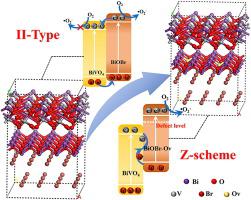Chemical Engineering Journal ( IF 15.1 ) Pub Date : 2022-06-23 , DOI: 10.1016/j.cej.2022.137757 Chun Liu , Shuai Mao , Mingxing Shi , Xianyong Hong , Dongting Wang , Fengyun Wang , Mingzhu Xia , Qun Chen

|
Constructing oxygen vacancies (Ov) has been widely used to enhance photocatalytic activity as a conventional and efficient approach, but its influence on the interfacial charge transfer pathway remains ambiguous. Herein, we synthesized BiVO4/BiOBr-Ov (BVB-Ov) photocatalysts through a facile method. Subsequently, various characterization results verified the successful preparation of BVB-Ov composites via combining BiVO4 with BiOBr containing oxygen vacancies (BiOBr-Ov). The results of photocatalytic degradation experiments illustrated that 20% BVB-Ov exhibited the highest degradation rate (91%) for Oxytetracycline (OTC), which was much higher than that of 20% BiVO4/BiOBr (71%). In addition, three possible degradation pathways were deduced from liquid chromatography-mass spectrometry (LC-MS) analysis. Photoelectrochemical, photoluminescence (PL) and time-resolved PL (TRPL) investigation revealed that 20% BVB-Ov possessed the fastest photogenerated carrier separation and transportation rate. Kelvin probe force microscopy (KPFM) technology and Density functional theory (DFT) calculations have shown that the introduction of oxygen vacancies modulated the relative positions of the Fermi levels between BiVO4 and BiOBr. We have finally combined DFT calculations, energy band analysis, trapping experiments and electron paramagnetic resonance (EPR) results, confirming that the existence of oxygen vacancies led to altering the photogenerated carrier transfer path from type-II to Z-scheme. This work provided insights and guidelines for oxygen vacancies to coordinate interfacial charge transfer pathways.
中文翻译:

通过结合费米能级改变和氧缺陷工程增强BiVO4/BiOBr的光催化降解性能
构建氧空位(Ov)作为一种传统且有效的方法已被广泛用于提高光催化活性,但其对界面电荷转移途径的影响仍不明确。在此,我们通过简便的方法合成了BiVO 4 /BiOBr-Ov (BVB-Ov) 光催化剂。随后,各种表征结果验证了通过将BiVO 4与含氧空位的BiOBr(BiOBr-Ov)结合成功制备BVB-Ov复合材料。光催化降解实验结果表明,20% BVB-Ov对土霉素(OTC)的降解率最高(91%),远高于20% BiVO 4/BiOBr (71%)。此外,从液相色谱-质谱 (LC-MS) 分析中推断出三种可能的降解途径。光电化学、光致发光 (PL) 和时间分辨 PL (TRPL) 研究表明,20% BVB-Ov 具有最快的光生载流子分离和传输速率。开尔文探针力显微镜 (KPFM) 技术和密度泛函理论 (DFT) 计算表明,氧空位的引入调节了 BiVO 4之间费米能级的相对位置和 BiOBr。我们最终结合了 DFT 计算、能带分析、俘获实验和电子顺磁共振 (EPR) 结果,证实了氧空位的存在导致光生载流子传输路径从 II 型到 Z 型的改变。这项工作为氧空位协调界面电荷转移途径提供了见解和指导。



























 京公网安备 11010802027423号
京公网安备 11010802027423号